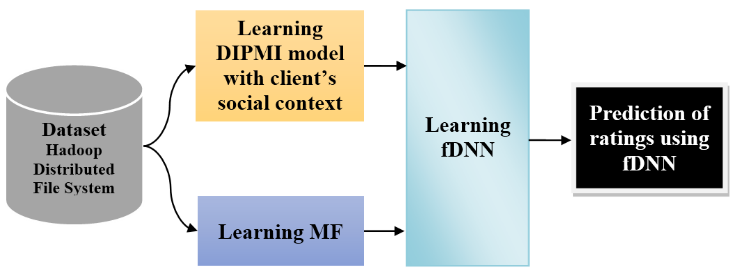Distributed Improved Deep Prediction for Recommender System using an Ensemble Learning
Main Article Content
Abstract
If online businesses possess valuable interest for suggesting their items by scoring them, then digital advertising gains their profits depending on their promotions or marketing task. Web users cannot be certain that the products handled via big-data recommendation are either advanced or interesting to their needs. In recent decades, recommender system models have been widely used to analyses large quantities of information. Amongst, a Distributed Improved Prediction with Matrix Factorization (MF) and Random Forest (RF) called DIPMF model exploits individual’s desires, choices and social context together for predicting the ratings of a particular item. But, the RF scheme needs high computation power and time for learning process. Also, its outcome was influenced by the training parameters. Hence this article proposes a Distributed Improved Deep Prediction with MF and ensemble learning (DIDPMF) model is proposed to decrease the computational difficulty of RF learning and increasing the efficiency of rating prediction. In this DIDPMF, a forest attribute extractor is ensemble with the Deep Neural Network (fDNN) for extracting the sparse attribute correlations from an extremely large attribute space. So, incorporating RF over DNN has the ability to provide prediction outcomes from all its base trainers instead of a single estimated possibility rate. This fDNN encompasses forest module and DNN module. The forest module is employed as an attribute extractor to extract the sparse representations from the given raw input data with the supervision of learning outcomes. First, independent decision trees are constructed and then ensemble those trees to obtain the forest. After, this forest is fed to the DNN module which acts as a learner to predict the individual’s ratings with the aid of novel attribute representations. Finally, the experimental results reveal that the DIDPMF outperforms than the other conventional recommender systems.
Article Details
References
N. Yin, “A big data analysis method based on modified collaborative filtering recommendation algorithms,” Open Physics, vol. 17(1), pp. 966-974, 2019.
M. Gao, J. Zhang, J. Yu, J. Li, J. Wen, and Q. Xiong, “Recommender systems based on generative adversarial networks: a problem-driven perspective,” Information Sciences, vol. 546, pp. 1166-1185, 2021.
M. Dhamecha, K. Dobaria, and T. Patalia, “A survey on recommendation system for bigdata using mapreduce technology,” IEEE 3rd International Conference on Computing Methodologies and Communication, pp. 54-58, 2019.
V. K. Sejwal, and M. Abulaish, “CRecSys: a context-based recommender system using collaborative filtering and LOD,” IEEE Access, vol. 8, pp. 158432-158448, 2020.
Z. Fayyaz, M. Ebrahimian, D. Nawara, A. Ibrahim, and R. Kashef, “Recommendation systems: algorithms, challenges, metrics, and business opportunities,” Applied Sciences, vol. 10(21), pp. 1-20, 2020.
M. Huang, J. OuYang, C. Wu, and L. Bo, “Collaborative filtering based on orthogonal non-negative matrix factorization,” Journal of Physics: Conference Series, IOP Publishing, vol. 1345(5), pp. 1-7, 2019.
B. A. Hammou, A. A. Lahcen, and S. Mouline, “An effective distributed predictive model with matrix factorization and random forest for big data recommendation systems,” Expert Systems with Applications, vol. 137, pp. 253-265, 2019.
M. Kavitha, and S. Subbaiah, “Big-data recommendation system using distributed improved predictive framework with matrix factorization and random forest,” International Journal of Intelligent Engineering & Systems, vol. 15(4), pp. 447-457, 2022.
R. Wang, H. K. Cheng, Y. Jiang, and J. Lou, “TDCF: a two-stage deep learning based recommendation model,” Expert Systems with Applications, vol. 145, pp. 1-10, 2019.
M. Riyahi, and M. K. Sohrabi, “Providing effective recommendations in discussion groups using a new hybrid recommender system based on implicit ratings and semantic similarity,” Electronic Commerce Research and Applications, vol. 40, pp. 1-13, 2020.
R. Kiran, P. Kumar, and B. Bhasker, “DNNRec: A novel deep learning based hybrid recommender system,” Expert Systems with Applications, vol. 144, pp.1-32, 2020.
S. Ahmadian, N. Joorabloo, M. Jalili, Y. Ren, M. Meghdadi, and M. Afsharchi, “A social recommender system based on reliable implicit relationships,” Knowledge-Based Systems, vol.192, pp. 1-17, 2020.
G. Yatnalkar, H. S. Narman, and H. Malik, “An enhanced ride sharing model based on human characteristics and machine learning recommender system,” Procedia Computer Science, vol. 170, pp. 626-633, 2020.
M. Rhanoui, M. Mikram, S. Yousfi, A. Kasmi, and N. Zoubeidi, “A hybrid recommender system for patron driven library acquisition and weeding,” Journal of King Saud University-Computer and Information Sciences, pp. 1-11, 2020.
A. F. O. U. D. I. Yassine, L. A. Z. A. A. R. Mohamed, and M. Al Achhab, “Intelligent recommender system based on unsupervised machine learning and demographic attributes,” Simulation Modelling Practice and Theory, vol. 107, pp. 1-16, 2021.
Q. Shambour, “A deep learning based algorithm for multi-criteria recommender systems,” Knowledge-Based Systems, vol. 211, pp.1-13, 2021.
R. Alabdulrahman, and H. Viktor, “Catering for unique tastes: targeting grey-sheep users recommender systems through one-class machine learning,” Expert Systems with Applications, vol. 166, pp. 1-12, 2021.

